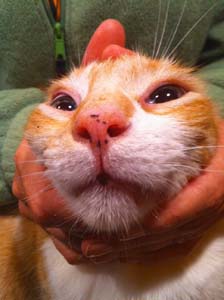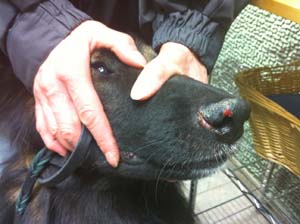Two Things About Your Pet's Nose You Should Know
April 23, 2012 | 53,155 views | + Add to Favorites
| 265 |
|
Print
|
Download Interview Transcript
Listen as Dr. Karen Becker discusses everything you ever wanted to know about your pet’s nose.
Visit the Pet Video Library
By Dr. Becker
There's been a myth floating around for years about what it means if your dog's or cat's nose is warm instead of cool, or dry instead of moist.
A warm dry nose by itself doesn't mean your pet is sick or has a fever.
In fact, your dog or cat's nose can be moist and cool one moment, and dry and warm the next, and it doesn't mean that he's sick.
It's all perfectly normal.
Now if your pet has other symptoms, like for instance loss of appetite, vomiting or diarrhea, lethargy, or other obvious signs of illness, then a dry, warm nose goes along with those other symptoms of systemic illness.
The time for a second look is if your pet's nose is changing texture.
For example, if it becomes flaky or crusty or you notice a change in the color.
If the nose is not only dry but the skin is also cracking, or if it's getting lighter in color … if you can see scabs, open sores, non-healing cracks or fissures, or other types of skin irritation … those are all things that you'll want your veterinarian to take a look at.
Your Pet's Nose Can Change Color for a Variety of Reasons
The color of your pet's nose can be black, pink (a pink nose is also called a Dudley nose), liver colored, or the same color as your dog's or cat's fur. Nose color is determined by genetics.
Some noses fade during the colder months and return to their normal color during the summer months. This is a condition known as 'snow nose' or 'winter nose.'
Certain breeds have noses that go from black to brown or pink as the dog ages. This is thought to be a result of the breakdown of tyrosinase, which is an enzyme that produces pigment. Since tyrosinase is also temperature-sensitive and works more efficiently in warmer weather, this could also explain the 'winter nose' color some dogs get when the weather gets cold.
If you happen to have an orange or calico kitty, you might notice that black spots appear on the nose and lips as your pet gets older. This is a totally normal change veterinarians call lentigo simplex, and it's no cause for concern.
Lentigo SimplexSometimes the nose will go lighter when the pet is sick and return to a darker color once health is restored. If a pet gets a scrape or other abrasion to the nose, often the nose skin will turn pink as the healing process is occurring, and then the darker natural color will appear as the scab wears away.
Contact dermatitis can also cause your dog or cat to lose pigment on the nose. Some pets have sensitivity to plastic food and water bowls, and continued exposure can cause the nose to lighten in color. Sometimes the lips will also become inflamed.
I recommend you use stainless steel food and water bowls, because aside from the potential for plastic hypersensitivities, plastics wear down over time, and the material in plastic bowls can leach into your pet's food and water.
The immune disease called vitiligo can also turn a dog's nose pink, but there are usually other signs of this disorder occurring at the same time, like your dog can have white hairs or entire patches of white hair all over her body.
With vitiligo, the immune system attacks the pigment-containing cells of the body that are responsible for color. Certain breeds seem more likely to develop vitiligo than others including Dobermans, German shepherds, Rottweilers, and Dachshunds.
Caring for Your Pet's Pink Nose
Whether your dog's nose is naturally pink or has turned pink either temporarily or permanently, you'll need to protect him from sunburn during the summer. You can apply a safe sunscreen when your dog will be out in the sun. It is important that you cover up pink noses during hot summer months.
There is a technique and actually a permanent solution to a pink nose some pet owners have opted for, but I don't recommend it.
Some veterinarians will suggest that you have your dog's nose tattooed black. I think this should be done only if your dog lives outdoors full time (which I absolutely don't recommend) and can't avoid contact with direct sunlight.
Otherwise, this is an unnecessary procedure and must be done under anesthesia.
Signs of a Nose Problem
If you notice a nasal discharge, swelling, an unpleasant smell from your dog's nose or the area around it, or if your pet seems to be having trouble breathing, it's time to call the vet.
These signs can point to a foreign object or a foreign body, an infection, or even a nasal tumor. If your pet's nose has a discharge from just one nostril, there could be a foreign body stuck up in there.
Other signs of an irritant, a foreign object, or a tumor in the nose include sneezing, pawing at the nose, or nosebleeds. Nasal polyps or tumors will often coincide with a bloody discharge or mucus from the nose.
You might also notice your pet's breathing is noisier than normal, and you can sometimes see a bulge or a lump on one side of the face or nose.
Diseases Affecting the Nose
Pemphigus complex is a group of very serious autoimmune skin diseases that affects both dogs and cats. There are two main types: pemphigus foliaceus and pemphigus erythematosus. Both start with patches of red skin on the face, including the nose and ears. The foliaceus variety often spreads to other parts of the body, including the feet, central body, core, and paws.
Pemphigus erythematosus involves only the face, head, and footpads. The red patches rapidly turn into blisters, and then pustules, which can become crusty and cause the hair to stick to them. They look like oozing, crusty sores. Areas of skin depigmentation are also seen with both of these disease processes.
There is a third type of pemphigus called pemphigus vulgaris, which is rare. Blisters and ulcers can form on the lips, nostrils, and eyelids with this particular disorder and it can also involve the nail beds, which can cause the nails to fall out.
Discoid lupus erythematosus is another autoimmune disease that can occur in dogs, but doesn't happen in cats. It's more common in certain breeds including Collies, German shepherds, Huskies, Shetland sheepdogs, and Brittany spaniels. It is thought to be a milder version of the systemic form of lupus, and limits itself only to the face. First the nose loses pigmentation, and then often it develops cracks and sores, non-healing fissures, as well as some crusting.
LupusAnother type of nose disorder is called zinc-responsive dermatosis. It's caused by a zinc deficiency and is prevalent in Huskies, Doberman pinschers, Great Danes, and Alaskan malamutes.
In zinc-responsive dermatosis, the dog's hair thins and a scaly, crusty rash can develop on the face that is most obvious on the nose, around the eyes, even in the ears, and around the mouth.
Crusting also appears on the elbows and hocks in some dogs. These areas can become callused and crack easily.
It's important to make sure your dog has a confirmed case of zinc-responsive dermatosis before you discuss supplementing zinc with your vet. Zinc toxicosis is actually more prevalent than zinc-responsive dermatosis due to pet owners over-supplementing with zinc, incorrectly assuming their dog has a deficiency.
Other nutritional deficiencies can also cause changes in nose tissue, especially omega-3 fatty acid deficiency, which can cause the nose tissue to become thickened and dry.
Omega-3 fatty acids are sensitive to heat and light, and their potency decreases over time when food is stored. It's no wonder that most pets consuming dry, kibbled food end up with essential fatty acid deficiencies.
Nasal solar dermatitis, also known as Collie nose, is a condition seen most often in sunny areas of the U.S. It primarily affects herding breeds including Collies, Aussies, and Shelties. With exposure to sunlight, the skin between the nose and muzzle first becomes quite irritated looking, the hair falls out, then the skin begins to ooze and crust over.
If the condition is allowed to continue with repeated sun exposure, the skin actually breaks down. And in serious cases, the nose can become just a big, giant, non-healing wound that's incredibly painful. Certainly, skin cancer has been known to develop out of advanced cases of this particular disease.
There are other systemic conditions which can affect the health of your dog's nose. The most common is hypothyroidism, which leads to a thickening of the nose and a leathery appearance.
Keeping an Eye on Your Pet's Nose
Checking your dog or cat's nose should be a normal part of your at-home wellness exam. Getting acquainted with the look and shape of your pet's nose when it's healthy is important, because then you'll be able to determine when a problem pops up and it becomes unhealthy.
You need to look for any unusual signs like nasal discharge, especially and certainly if it goes from clear to mucus-y or bloody. You also need to stay alert for excessive dryness, crusting, or loss of pigmentation.
I also recommend you watch the nose as your pet breathes. Dogs and cats are nose breathers when at rest. If the nostrils flare more than normal, your pet could be having a breathing problem.
If you notice anything unusual about your pet's nose, especially if you are seeing other signs of illness, I certainly recommend you make an appointment with your veterinarian.
As some of you know, topical ointments applied to the nose are often totally useless, because they become oral supplements in a matter of seconds to minutes in most dogs and cats.
The only supplement I recommend applying to your pet's nose while you're waiting for your vet appointment is natural vitamin E. You can actually poke a vitamin E capsule to open it, squeeze out the contents, and apply it to your pet's nose until you can be seen by your vet.
Other creams and salves can be fairly irritating to your pet's nose, so I don't recommend you apply other products unless you have specifically been told to do so by your veterinarian.


















